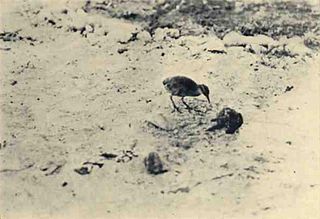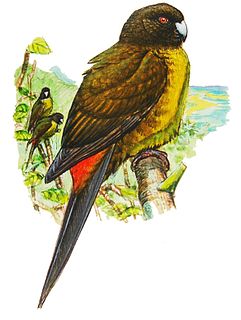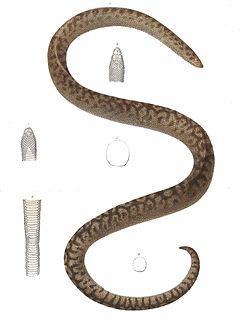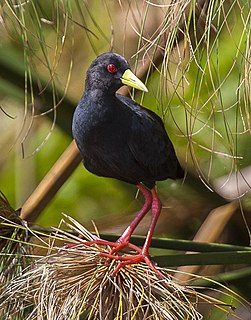
The little crake is a very small waterbird of the family Rallidae. parva is Latin for "small".

Baillon's crake, also known as the marsh crake, is a small waterbird of the family Rallidae.

The ruddy-breasted crake, or ruddy crake, is a waterbird in the rail and crake family Rallidae.
Friedrich Heinrich, Freiherr von Kittlitz was a Prussian artist, naval officer, explorer and naturalist. He was a descendant of a family of old Prussian nobility. He collected specimens and made illustrations on major expeditions and wrote a few books on his travels. Several species were described on the basis of specimens collected by him and a few are named after him including Kittlitz's plover.

The Bonin wood pigeon was a pigeon endemic to Nakodo-jima and Chichi-jima in the Ogasawara Islands, south of Japan. It is known from four recorded specimens, the first from 1827 and the last from 1889. They averaged a length of 45 cm. This pigeon died out late in the 19th century as a result of deforestation, hunting, and predation by introduced rats and cats.

The Tanna ground dove, also known as Forster's dove of Tanna, is an extinct dove species. Its taxonomic affiliation is uncertain but at its first scientific discussion by Johann Georg Wagler in 1829 it was classified into the genus Gallicolumba ; its closest relative is possibly the Santa Cruz ground dove. It was endemic to the Pacific island of Tanna, Vanuatu. Forster records a native name mahk, almost certainly from the Kwamera language.

The extinct Wake Island rail was a flightless rail and the only native land bird on the Pacific atoll of Wake. It was found on the islands of Wake and Wilkes, but not on Peale, which is separated from the others by a channel of about 100 meters. It was hunted to extinction during the Second World War.

The Bonin thrush, also known as Kittlitz's thrush or the Bonin Islands thrush, is an extinct species of Asian thrush. It is sometimes separated as the only species of the genus Cichlopasser. The only place where this bird was found was Chichi-jima in the Ogasawara Islands; it might conceivably have inhabited Anijima and Otōtojima, but this has not been borne out by observations or specimens. The species was only once observed by a naturalist, its discoverer Heinrich von Kittlitz. He encountered the thrush in the coastal woods where it usually kept to the ground; it may have been ground-nesting. The only specimens ever taken are in the Naturalis in Leiden (1), the Naturhistorisches Museum in Vienna (1), the Senckenbergmuseum in Frankfurt (1) and in the Zoological Museum, St. Petersburg (2).

The Bonin nankeen night heron is an extinct subspecies of the nankeen night heron.

Coues's gadwall or the Washington Island gadwall, is an extinct dabbling duck which is only known by two immature specimens from the Pacific island of Teraina, Line Islands, Kiribati. They are in the National Museum of Natural History in Washington, D.C. The bird was named in honor of Elliott Coues.

The Raiatea parakeet or Society parakeet, also known as the Society kakariki or brown-headed parakeet, is an extinct parakeet of the genus Cyanoramphus.

The Round Island burrowing boa is an extinct species of snake, in the monotypic genus Bolyeria, in the family Bolyeriidae. The species, which was endemic to Mauritius, was last seen on Round Island in 1975. There are no recognized subspecies.

The Kosrae starling, also known as Kosrae Island starling, and formerly as Kusaie Mountain starling, is an extinct bird from the family of starlings (Sturnidae). It was endemic to the montane forests on the island of Kosrae which belong to the Caroline Islands in the south-western Pacific.

Porzana is a genus of birds in the crake and rail family, Rallidae. Its scientific name is derived from Venetian terms for small rails. The spotted crake is the type species.

The Saint Helena crake is an extinct bird species from the island of Saint Helena in the South Atlantic Ocean, one of two flightless rails which survived there until the early 16th century.
The Tasman starling was described in 1836 by John Gould as a species which occurred on both Norfolk Island and Lord Howe Island. In 1928 Australian ornithologist Gregory Mathews recognized that the plumage of the race from Lord Howe Island was much browner and more greyish than the plumage of the Norfolk Island race and split the species into two forms, the Norfolk starling, and the Lord Howe starling. Both subspecies are now extinct, thus so the species.

The spotless crake is a species of bird in the rail family, Rallidae. It is widely distributed species occurring from the Philippines, New Guinea and Australia, across the southern Pacific Ocean to the Marquesas Islands and south to New Zealand.

The Mexican grizzly bear is an extinct population of the grizzly bear in Mexico.

Zapornia is a genus of birds in the rail family Rallidae.

The Carolines tropical moist forests is a tropical and subtropical moist broadleaf forests ecoregion in Micronesia. It includes the central and eastern Caroline Islands in the Federated States of Micronesia.


















